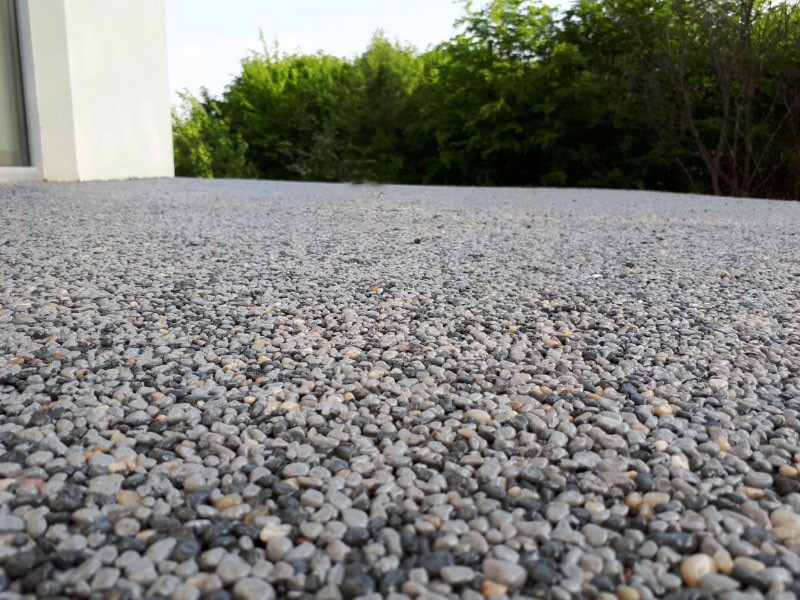Naziv vsebine
STABILIT UV binding agent for stone carpets 5 kg
STABILIT is a UV stable one-component polyurethane binding agent for binding stone granulates, sands, pebbles, and similar materials.
Usage:
- stone mats
- bicycle paths and pedestrian walkways
- yards
- areas around trees
- walking surfaces in parks
- grouting or stabilization of joint sand in natural stone and concrete pavers
- logos with colored sands
Color:
transparent, does not yellow under UV rays (suitable for white sands as well).
Conditions for execution:
Ideal stone granulations are washed, kiln-dried, and dust-free fractions in a narrower range of granulations, e.g., 2-4 mm, 5-8 mm, 3-8 mm,... Due to permeability and greater strength, it is important that the pebbles are rounded and not crushed. The ground must be leveled and properly compacted to a thickness of at least 25 cm before application. It must be ensured that surface water does not stagnate or is properly drained.
The minimum thickness of the stone carpet application must be at least 30 mm.
Consumption of the binding agent: depends on granulation; usually below 6 weight %.
Approximate mixing ratios of Stabilit binding agent : sand
Sand granulation 0.7-1.2 and 1-2mm: 6 % Stabilit (= 1 kg Stabilit + 17 kg sand)
Sand granulation 2-4mm: 5 % Stabilit (= 1 kg Stabilit + 20 kg sand)
Sand granulation 4-8mm: 4 % Stabilit (= 1 kg Stabilit + 25 kg sand)
Sand granulation 8-12mm: 3-4 % Stabilit (= 1 kg Stabilit + 25-28 kg sand)
Larger sand granulations: approx. 3 % Stabilit
Quartz sand 0.60 – 1.20 mm approx. 10 kg/m² at a thickness of 5 mm approx. 0.50 kg/m² (max. 5% to the amount of sand)
Quartz sand 2.00 – 3.50 mm approx. 14 kg/m² at a thickness of 8 mm approx. 0.70 kg/m² (max. 5% to the amount of sand)
Marble or quartz 2.00 – 6.00 mm approx. 17 kg/m² at a thickness of 10 mm approx. 0.85 kg/m² (max. 5% to the amount of sand)
Grouting natural stone and concrete pavers with sand 0.7-1.2mm: approx. 1.25 kg Stabilit per 25 kg sand
For larger quantities, it is recommended to use a planetary mixer with 300 revolutions/minute; mixing time 3-5 minutes.
Working conditions: temperature range (ground, material, and air) 8-25 °C, optimal humidity 50-70 %
Usability time of the mixture or max. time until installation:
at 10°C: 40 minutes
at 20°C: 30 minutes
at 30°C: 20 minutes
During installation, the material must be properly compacted or hardened, and if necessary, rolled.
Application on concrete surfaces: If the substrate is concrete, it is necessary to mechanically clean dry concrete (below 4% moisture), vacuum the dust, and prime with Epoxy 210 resin, which is sprinkled with Geba quartz while wet. After 24 hours (at 20°C), a layer of sand with Stabilit binding agent can be applied. On concrete, we recommend a layer thickness of at least 25 mm. It is mandatory to create a dilation joint every 100 m2 or 10 linear meters. The same applies to all joints with curbs and similar. A 5 mm EPS strip or similar can be used. Later, the dilation joint is filled with elastic polyurethane.
Walking strength: 24 hours Final strength: 72 hours
Storage: 6 months at a temperature of 15-25°C.
Usage:
- stone mats
- bicycle paths and pedestrian walkways
- yards
- areas around trees
- walking surfaces in parks
- grouting or stabilization of joint sand in natural stone and concrete pavers
- logos with colored sands
Color:
transparent, does not yellow under UV rays (suitable for white sands as well).
Conditions for execution:
Ideal stone granulations are washed, kiln-dried, and dust-free fractions in a narrower range of granulations, e.g., 2-4 mm, 5-8 mm, 3-8 mm,... Due to permeability and greater strength, it is important that the pebbles are rounded and not crushed. The ground must be leveled and properly compacted to a thickness of at least 25 cm before application. It must be ensured that surface water does not stagnate or is properly drained.
The minimum thickness of the stone carpet application must be at least 30 mm.
Consumption of the binding agent: depends on granulation; usually below 6 weight %.
Approximate mixing ratios of Stabilit binding agent : sand
Sand granulation 0.7-1.2 and 1-2mm: 6 % Stabilit (= 1 kg Stabilit + 17 kg sand)
Sand granulation 2-4mm: 5 % Stabilit (= 1 kg Stabilit + 20 kg sand)
Sand granulation 4-8mm: 4 % Stabilit (= 1 kg Stabilit + 25 kg sand)
Sand granulation 8-12mm: 3-4 % Stabilit (= 1 kg Stabilit + 25-28 kg sand)
Larger sand granulations: approx. 3 % Stabilit
Quartz sand 0.60 – 1.20 mm approx. 10 kg/m² at a thickness of 5 mm approx. 0.50 kg/m² (max. 5% to the amount of sand)
Quartz sand 2.00 – 3.50 mm approx. 14 kg/m² at a thickness of 8 mm approx. 0.70 kg/m² (max. 5% to the amount of sand)
Marble or quartz 2.00 – 6.00 mm approx. 17 kg/m² at a thickness of 10 mm approx. 0.85 kg/m² (max. 5% to the amount of sand)
Grouting natural stone and concrete pavers with sand 0.7-1.2mm: approx. 1.25 kg Stabilit per 25 kg sand
For larger quantities, it is recommended to use a planetary mixer with 300 revolutions/minute; mixing time 3-5 minutes.
Working conditions: temperature range (ground, material, and air) 8-25 °C, optimal humidity 50-70 %
Usability time of the mixture or max. time until installation:
at 10°C: 40 minutes
at 20°C: 30 minutes
at 30°C: 20 minutes
During installation, the material must be properly compacted or hardened, and if necessary, rolled.
Application on concrete surfaces: If the substrate is concrete, it is necessary to mechanically clean dry concrete (below 4% moisture), vacuum the dust, and prime with Epoxy 210 resin, which is sprinkled with Geba quartz while wet. After 24 hours (at 20°C), a layer of sand with Stabilit binding agent can be applied. On concrete, we recommend a layer thickness of at least 25 mm. It is mandatory to create a dilation joint every 100 m2 or 10 linear meters. The same applies to all joints with curbs and similar. A 5 mm EPS strip or similar can be used. Later, the dilation joint is filled with elastic polyurethane.
Walking strength: 24 hours Final strength: 72 hours
Storage: 6 months at a temperature of 15-25°C.
DANGEROUS
H332 Harmful to health if inhaled.
H315 Causes skin irritation.
H319 Causes severe eye irritation.
H334 May cause allergy or asthma symptoms or breathing difficulties if inhaled.
H317 May cause an allergic skin reaction.
H351 Suspected of causing cancer.
H335 May cause irritation of the respiratory tract.
H373 May cause damage to organs through prolonged or repeated exposure.
P280 Wear protective gloves/protective clothing/eye protection/face protection.
P305 + P351 + P338 IN CASE OF CONTACT WITH EYES: Rinse cautiously with water for several minutes. Remove contact lenses, if present and easy to do. Continue rinsing.
P260 Do not inhale dust/smoke/gas/mist/vapors/aerosols.
P284 [In case of insufficient ventilation] wear respiratory protection equipment.
P405 Keep locked up.
P501 Dispose of contents/container in accordance with regulations.






